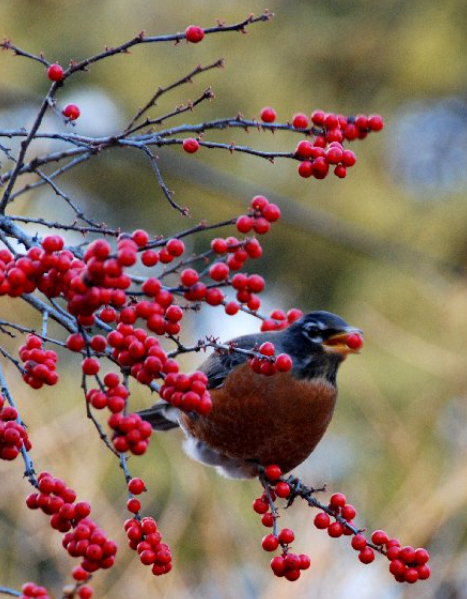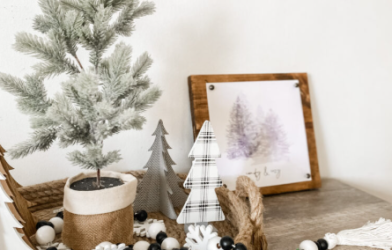Subtotal $0.00
During the cold months, winter berries provide much-needed color in the garden and serve as a vital food source for birds. These berries, rich in sugar and fats, help our feathered friends survive the winter chill and sustain them as they migrate. As I watch various birds feast on ripening berries like toyon and dogwood in my garden, I am reminded of the joy these plants bring not only to gardeners but also to the wildlife that depend on them.
If you’re looking to add vibrant winter berries to your garden, here are a few of my favorite varieties that have become staples in my landscape.
Toyon (Heteromeles arbutifolia)
Zones 7-11
One of the best winter berry-producing shrubs in my garden is the native toyon. This evergreen shrub grows up to 20 feet tall and produces striking red berries that stand out against its dark green leaves. When planted near a gray eucalyptus, the contrast is stunning. Once the berries ripen, bluebirds and robins flock to the shrub, quickly devouring its bounty.
Symphoricarpos ‘Proud Berry’ (Snowberry)
Zones 3-7
Snowberries often come in the classic white, but I especially love varieties like ‘Proud Berry’ and ‘Charming Fantasy’ for their pink hues. These varieties brighten up my garden in Lake Tahoe, thriving in the colder climates and adding a pop of color during the bleak winter months.
Gaultheria procumbens (Wintergreen)
Zones 3-9
Wintergreen is a tough plant in my garden, thriving even in harsh conditions. Planted at the base of my hill where the water table is high, wintergreen has survived scorching summers, attacks from wild turkeys, and even hungry deer. The berries are edible and have a refreshing, minty flavor that adds another layer of interest.
Malus ‘Adam’ (Crabapple)
Zones 4-8
The ‘Adam’ crabapple tree is one of my favorite winter berry producers. My mother’s tree is filled with cranberry-red fruits that hang on well into January. The vibrant red berries, paired with the red foliage of nearby nandina, create a striking winter color combination that really stands out in the garden.
Crataegus pinnatifida (Mountain Hawthorn)
Zones 5-9
This compact tree offers everything I love: beautiful fall foliage, vibrant winter berries, and drought resistance. It thrives in dry conditions, making it a great addition to gardens with hot summers. The berries add both color and texture during the colder months, making it a wonderful focal point in any garden.
Pyracantha coccinea (Firethorn)
Zones 5-8
Pyracantha is a shrub that many people love to hate due to its sharp thorns, but I can’t help but adore it. The plant produces a stunning display of white flowers in spring and vibrant berries in winter, attracting a variety of birds, including cedar waxwings and robins. Its evergreen foliage makes it perfect for creating a year-round screen or hedge.
Cotoneaster dammeri (Bearberry)
Zones 5-8
This low-growing cotoneaster variety is great for erosion control on slopes or cascading over walls. The small red berries provide visual interest throughout the winter, and it’s an excellent choice for gardeners looking for a versatile, low-maintenance shrub.
Viburnum opulus ‘Compactum’ (European Cranberry Bush)
Zones 3-8
With its red foliage in the fall and cranberry-like berries in winter, the European cranberry bush is a showstopper in any garden. It’s a perfect addition to the middle of a border and grows to about 5 feet by 5 feet. The berries are loved by birds, adding life and color to the winter garden.
Cornus alba ‘Elegantissima’ (Variegated Red Twig Dogwood)
Zones 2-8
This red twig dogwood offers beautiful variegated leaves and bright blue-tinged berries that bring contrast and color to the winter garden. It’s an essential plant in my Lake Tahoe garden, adding interest during the cold months.
Ilex verticillata (Winterberry Holly)
Zones 3-9
Winterberry holly is another fantastic winter berry plant. After discovering it at the Little Island Garden in New York, I knew I had to add it to my collection. While it prefers moist conditions, I’ve had success growing it in my garden, providing a wonderful winter display of red berries that last well into the cold months.
Rhaphiolepis umbellata ‘Blueberry Muffin’
Zones 7b-10
This evergreen shrub is a true gem in my garden. It’s tough, low-maintenance, and produces blue-tinged berries that attract birds. It thrives in full sun and requires very little water, making it ideal for my low-maintenance garden.
Sarcococca rustifolia (Sweet Box)
Zones 7-9
I love planting sweet box near the entrance of a home to enjoy its fragrance up close. This evergreen shrub thrives in deep shade, is drought-tolerant, and blooms in the winter, providing both a sweet fragrance and dark berries that add a touch of color.
Myrica californica (Pacific Wax Myrtle)
Zones 6-11
Myrica, or Pacific Wax Myrtle, is a versatile shrub that I use in my garden as a hedge alternative. It’s tough, produces flowers and winter berries, and fits in with almost any garden style. I love how it was used at Arlington Garden in Pasadena to create a formal hedge in a more casual space.
Mahonia aquifolium (Oregon Grape)
Zones 5-9
Oregon grape is a diverse shrub that can range from low-growing varieties to taller, upright plants. Its yellow autumn flowers are followed by dark blue berries that birds love. The foliage is sometimes prickly but also adds texture and interest to the garden.












